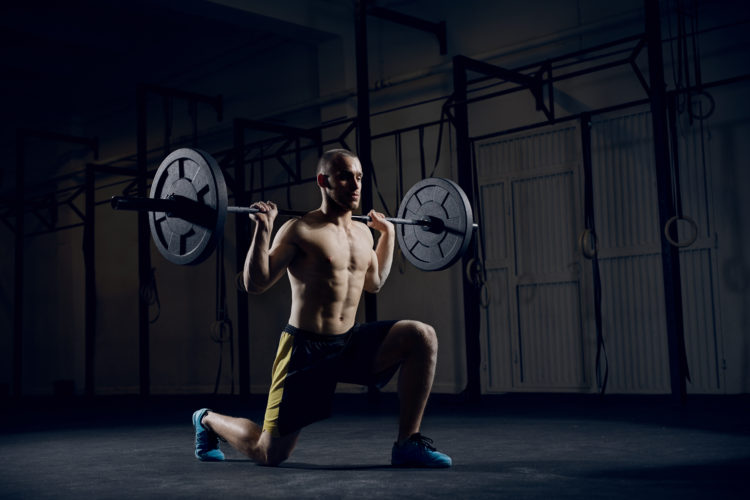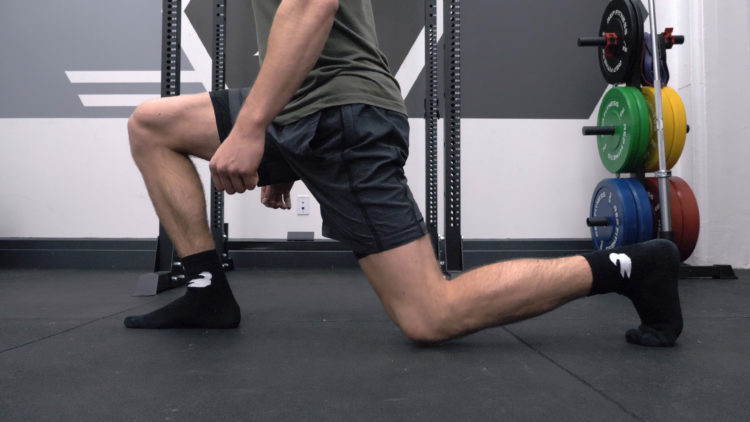No matter how you prefer to train or what strength sport you compete in, unilateral lower body training should be a staple in your workouts. Unilateral training can best be described as training that kills multiple birds (yes, more than two) with one stone. In this article, we’re going to focus specifically on three different lunge variations and how to use each in training.
The lunge is a fantastic lower body movement because it comes with multiple variations, and you can load it in multiple ways. And the best part of experimenting with lunge variations in training is that each variation will have slightly different hyper-specific adaptations that will come along with them.
The way you perform lunges and the way you load them should be catered to specific training goals. So before doubling down and only performing one lunge variation, let’s explore a few different options, along with how and when to use them.

Benefits of Lunges
Before we talk lunge variations, let’s first cover the benefits of performing lunges in training. Note, the benefits below that come attached with lunges, as with any exercise, will shift in a hierarchy fashion depending on how the body is being loaded and which variation is being performed.
- Improve Strength. This one’s a no-brainer, if you load the legs, then you’ll strengthen the legs.
- Increase Balance/Proprioception. Unilateral movements require the body to create strong postures with a less stable base. This makes lunges a great option for improving balance, along with building awareness when moving through different movement planes.
- Carryover to Sport. Rarely are movements in sport straightforward with perfect execution. If you can master the lunge in multiple directions and conquer the postures required in each, then you can create carryover when in somewhat similar positions during sport.
- Limit Stress. Lunges won’t be loaded nearly as heavily as bilateral movements (squats, front squats, etc.), so they’re a great option for limiting axial loading while still providing training benefit.
- Highlight Weaknesses/Imbalances. When squatting all of the time, it can be hard to identify potential imbalances/weaknesses that have been built. By taking the ankles, knees, and hips through different, often greater, ranges of motion, we can highlight areas that we may be lacking in.
Lunge Vs Split Squat: Is There a Difference?
The lunge and split squat are both very similar in nature and provide similar benefits, but there is a main difference between them. The main difference between these two is exercises is the lunge requires a stepping motion where at least one foot is moving each rep, while the split squat is performed from a static position.
There are smaller differences that exist between each like weight distribution and training intent as well, but the above is the main fundamental difference If you want a more thorough explanation of this difference with exercise tutorials, check out our lunge vs split squat video below!
Lunge Loading Matters
There are multiple ways to load the lunge and different loading styles will have slightly different muscle activity and adaptations. This is where being creative as a coach and athlete comes into play, as the type of loading programmed should account for a few thoughts like:
- Does the loading have specific sport-focused carryover?
- Is the loading manageable based on your total energy levels and work capacity for said workout?
- Does the loading match your skill level for successful execution of reps?
Some examples of this could include opting for dumbbells over a barbell because the prior working set squats completely wiped out one’s ability to efficiently axial load without compensation, or if total spinal loading is trying to be limited. Another example could be opting to hold a barbell in a front rack position to practice the skill of maintaining a vertical torso when performing lower body movements.
Some ways you can load lunges include:
- Barbell on back
- Barbell in front rack
- Dumbbells/Kettlebells in both hands
- One dumbbell/kettlebell in strong side hand, or contra lateral hand
- Zercher barbell hold
- Dumbbell/Kettlebells in both hands overhead
- One dumbbell/kettlebell in strong side hand above head, or contra lateral hand above head
This list could go on and that’s again, the beauty of lunges. All of the loading examples above will have slightly different adaptations on sport carryover and muscle activation.
A great example of this comes from a 2015 study published in the Journal of Strength and Conditioning Research where researchers suggested that front walking lunges with a contralateral load had slightly higher glute medius EMG ratings when compared to a dumbbell held on the walking side. (1)
1. Front Walking/Stepping Lunge
The front walking/stepping lunge is probably the most common lunge variation used in training and is one the best options for beginners to conquer before trying other variations. This lunge can be performed by physically taking repetitive steps for each rep, or by stepping forward, then driving back upwards to the original starting position.
When to Use It
The front walking/stepping lunge can be employed in nearly every training setting, as it’s generally one of the easier lunge variations to load heavy if strength is a main goal. This variation is also a great option for teaching unilateral loading and movement patterns for beginners because a front stepping motion often feels more natural than backwards or laterally.
2. Reverse Lunge
The reverse lunge is another great option for employing in nearly every training setting. The act of stepping backwards with weight is an awesome variation for loading the front leg, but also focusing on building hip strength in the leg that is stepping backwards.
When to Use It
Like the front walking/stepping lunge, the reverse lunge is another option that can be employed for nearly every training session. If there’s more of an intent to focus on the hips, then this lunge variation is useful to employ because the backward step can often be elongated slightly more than forward lunges and the back foot plays more or less an equal role as a prime mover.
3. Lateral Lunge
The lateral lunge is one of the more complex lunge variations, but once it’s learned and accomplished, it’s an awesome variation for strengthening the hips and pelvis through an often undertrained range of motion.
When to Use It
The lateral lunge can be useful to use when hip and ankle mobility and knee stability tend to be limiting factors during squat-style movements. A 2013 study published in the Journal of Sports Medicine and Physical Fitness compared lateral and front stepping lunges with varied step lengths and suggested that the lateral lunge put the ankle through a great range of motion and required an increase in knee kinetic contributions. (2)
It’s also a great variation for teaching pelvis stability with a lateral focus, working on improving range of motion with tight adductors, and improving body awareness.
How to Vary Lunges Even More
Outside of the above loading and directional parameters, how else can lunge training be varied?

1. Add Elevation
A popular variation that typically accompanies split squats is the addition of an elevated surface. With lunges this would look like standing on a plate, then performing a stepping or reverse lunge, then returning back to the starting position on the plate.
This addition is fantastic for taking the legs, more specifically the hips, through a greater range of motion and teaching control. For those trying to improve hip stability, try adding a 25 lb bumper or 45 lb metal plate under the feet, then performing front stepping or reverse lunges.
Author’s Note: Try to find a plate that is fully flat and keep the height lower to start, then progress height as a way of increasing intensity.
2. Add Tempo, Pauses, and Half Reps
Another way to vary lunge training is with the use of tempos, pauses, and half reps. These are all fantastic tools for increasing the time under tension we’re putting the legs under. If the goal is increasing intensity without physical load, then these options are worth exploring and employing.
Wrapping Up
Lunges are a great unilateral lower body exercise that can be used for accomplishing multiple training goals. When it comes to programming, the sky is the limit for their best uses when considering the multiple lunge variations that can be performed, along with how they can be loaded, then manipulated even further!
At the end of the day, the main goal should be performing lunge variations with intent, and not simply programming flashy variations for the sake of it.
Lunge FAQs
What are benefits of lunges?
There are multiple benefits that come along with using lunges in your training. Some of the biggest benefits include:
- Increase leg strength
- Improve balance/proprioception
- Up lower body work capacity
- Support carryover to sport
Can beginners perform lunges?
Absolutely. In fact, one of the best parts about lunges is how applicable they can be for any fitness level. A great way to progress with lunge training includes starting with front stepping bodyweight lunges, working to dumbbells, then adding steps.
Do different lunges train different muscles?
Yes and no. In general, each lunge variation will train similar muscle groups, but the activation of particular muscles will vary depending on the variation. For example, the adductors will be worked more in a lateral lunge compared to front stepping lunge due to the difference in range of motion for each.
References
1. Stastny, P., Lehnert, M., Zaatar, A., Svoboda, Z., & Xaverova, Z. (2015). Does the Dumbbell-Carrying Position Change the Muscle Activity in Split Squats and Walking Lunges?. Journal Of Strength And Conditioning Research, 29(11), 3177-3187.
2. Riemann B, e. (2020). Biomechanical comparison of forward and lateral lunges at varying step lengths. – PubMed – NCBI.
